

Lunedale Geology - Images
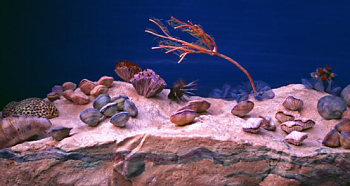
Lunedale about 320 Million Years Ago
Reconstruction of the tropical sea floor, about 320 million years ago during the Carboniferous Period, with corals, crinoids, bryozoa and a variety of shells.
This is a photograph of a model, built by Peter Young in 2006, in the Bowless Visitor Centre, Teesdale.
Greengates Quarry
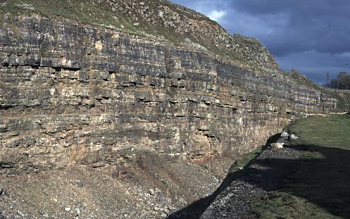 The
Five Yard Limestone and associated sandstones and shales exposed in the north
wall of the quarry.
The
Five Yard Limestone and associated sandstones and shales exposed in the north
wall of the quarry.
The dolerite dyke has been excavated from the deepest part of the quarry, at the foot of the high face.
Closehouse Mine
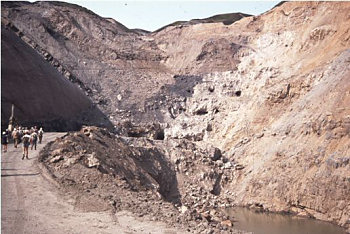 The
working face of the opencast pit in 1984 showing the wide barytes vein and
folded limestone beds on the left.
The
working face of the opencast pit in 1984 showing the wide barytes vein and
folded limestone beds on the left.
Closehouse Mine
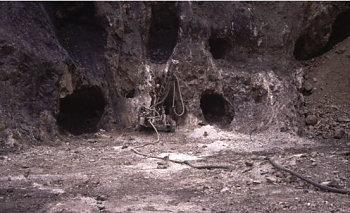 Old
underground workings in the wide barytes vein, exposed in the opencast pit in
1990.
Old
underground workings in the wide barytes vein, exposed in the opencast pit in
1990.
Hunter's Vein, Lunehead
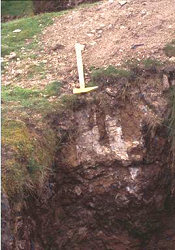 Outcrop
of Hunter’s Vein, here containing witherite and barytocalcite, in limestone
wallrock.
Outcrop
of Hunter’s Vein, here containing witherite and barytocalcite, in limestone
wallrock.
Barytocalcite
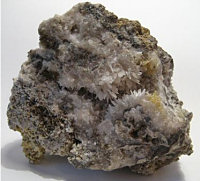 A
fine specimen from the workings on Hunter’s Vein.
A
fine specimen from the workings on Hunter’s Vein.
Characteristic narrow white crystals protrude into cavities
This specimen is about 7 cm across: individual crystals are up to about 2 mm long.
Galena
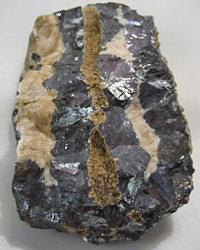 Typical
metallic crystalline galena interbanded with baryte. Closehouse Mine.
Typical
metallic crystalline galena interbanded with baryte. Closehouse Mine.
The specimen is about 12 cm long.
Pyromorphite
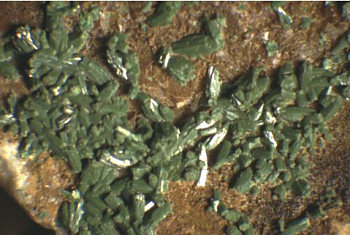 Deep
green crystals on baryte.
Deep
green crystals on baryte.
Although a common mineral in lead veins, pyromorphite is rather uncommon in the Northern Pennines. Closehouse Mine was the source of some of the finest examples found in the Pennines.
Individual crystals on this specimen are up to about 3 mm long.
Rosasite
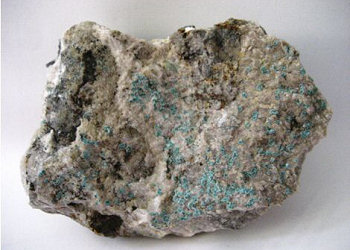 Small
turquoise-blue globules on baryte.
Small
turquoise-blue globules on baryte.
One of several good specimens of this rather uncommon Northern Pennine mineral that were collected at Closehouse Mine in the 1980s.
This specimen is about 10 cm across: the blue globules are up to 2 mm across.
Anglesite
 Sharply
pointed crystals from Closehouse Mine.
Sharply
pointed crystals from Closehouse Mine.
Although a rather common mineral, good crystals are more unusual. Some very fine examples, such as this one, were obtained at Closehouse in the 1980s.
These crystals, which are up to about 2 mm long, have been photographed under a scanning electron microscope.
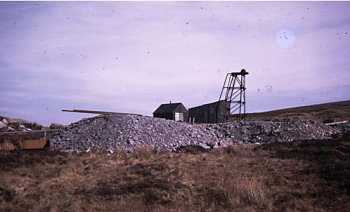 The
headframe and dumps at a small trial shaft in 1974.
The
headframe and dumps at a small trial shaft in 1974. Old
opencast workings on the outcrop of the vein.
Old
opencast workings on the outcrop of the vein.